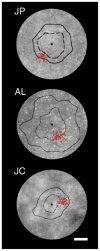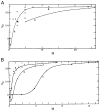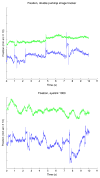The significance of microsaccades for vision and oculomotor control
- PMID: 19146321
- PMCID: PMC3522523
- DOI: 10.1167/8.14.20
The significance of microsaccades for vision and oculomotor control
Abstract
Over the past decade several research groups have taken a renewed interest in the special role of a type of small eye movement, called 'microsaccades', in various visual processes, such as the activation of neurons in the central nervous system, or the prevention of image fading. As the study of microsaccades and their relation to visual processes goes back at least half a century, it seems appropriate to review the more recent reports in light of the history of research on maintained oculomotor fixation, in general, and on microsaccades in particular. Our review shows that there is no compelling evidence to support the view that microsaccades (or, fixation saccades more generally) serve a necessary role in improving oculomotor control or in keeping the visual world visible. The role of the retinal transients produced by small saccades during fixation needs to be evaluated in the context of both the brisk image motions present during active visual tasks performed by freely moving people, as well as the role of selective attention in modulating the strength of signals throughout the visual field.
Figures








References
-
- Arend LE, Timberlake GT. What is psychophysically perfect image stabilization? Do perfectly stabilized images always disappear? Journal of the Optical Society of America A, Optics and Image Science. 1986;3:235–241. - PubMed
-
- Bahcall DO, Kowler E. Attentional interference at small spatial separations. Vision Research. 1999;39:71–86. - PubMed
-
- Bahill AT, Adler D, Stark L. Most naturally occurring human saccades have magnitudes of 15 degrees or less. Investigative Ophthalmology. 1975;14:468–469. - PubMed
-
- Bahill AT, Kallman JS, Lieberman JE. Frequency limitations of the two-point central difference differentiation algorithm. Biological Cybernetics. 1982;45:1–4. - PubMed
-
- Ballard DH, Hayhoe MM, Pelz JB. Memory representations in natural tasks. Journal of Cognitive Neuroscience. 1995;7:66–80. - PubMed
Publication types
MeSH terms
Grants and funding
LinkOut - more resources
Full Text Sources
Other Literature Sources
Research Materials
Miscellaneous

